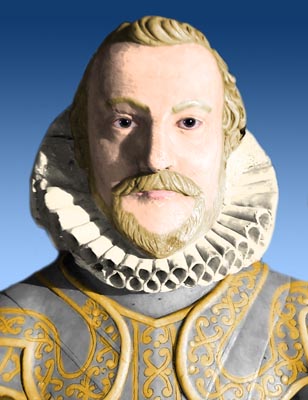 |
 |
|||
|
Pieter, the third son of Maurice Van Loor and his wife, Stephanie, was born in Utrecht in the Netheralnds about 1547. He came to England, where he was known as Peter Vanlore, around the age of twenty-one and lodged in the parish of St. Dunstan-in-the-West in London. By 1578, he was operating as a jewel merchant in St. Benet’s Sherehog. He married Jacoba, the daughter of Henry Teighbott around 1585 and the two built up a thriving business which, by the 1590s was supplying the Royal Court with a considerable amount of jewellery. In December 1594, for instance, Queen Elizabeth I paid Vanlore £1,700 for a sting of pearls, and such Royal patronage substantially increased under King James I. Within the first eighteen months of his reign, he spent some £30,000 on Vanlore gems. Albeit that he purchased back £15,000 of the Queen’s jewels in 1619 in order for the King to fund a Royal progress. Peter also apparently financed lucrative voyages to the West Indies and so adopted a native American boy as his family crest (the old story that this was a murdered servant is completely apocryphal). Since he dealt in such large amounts of money, it was not long before Peter turned to banking and quickly became one of the most prominent foreign merchants lending money to the Crown. In 1621, for example, he leant a third of the £30,000 needed for a proposed expedition to restore the King’s son-in-law as ruler of the Palatinate on the Continent. His loyal service gained him a knighthood at Whitehall on 5th November that same year, although no repayments were forthcoming until long after King James was dead. However, Sir Peter had always managed to make profits from other Royal favours such as the licence granted him in 1604 to export 15,000 broadcloths duty free for ten years. The following year, he was part of a syndicate which sold on a similar licence to the Merchant Adventurers. He also speculated in the buying and selling of Crown lands. Sir Peter’s main residence was his London town-house in Fenchurch Street. However, in 1604, he purchased the manor of Tilehurst in Berkshire, and the manor house at Calcot became his country seat. He quickly expanded his Thames Valley estates by foreclosing on a number of mortgages. In 1625, he was successful in obtaining Sonning from the creditors of the Earl of Kellie and, by the time of his death, he was a man of great influence with the largest estate in the county. Sir Peter was naturalized on
5th May 1610, but, as a foreign-born merchant, he always remained vulnerable
to persecution in one form or another, even despite friendships with men
such as the Lord Keeper, Sir Thomas Coventry. In 1619, in order to avoid
their financial obligations, the government trumped up a charge of illegal
export of bullion against a number of Dutch merchant strangers, Vanlore
amongst them. He was given a fine of £7,000 and, according to Chamberlain,
was so incensed that he threatened to leave the country forever. He stayed
however, apparently because his children’s inheritance was almost entirely
tied up in English estates. He eventually died on 6th September 1627 and was
buried in Tilehurst Church
beneath a magnificent renaissance monument. His widow remarried to Peregrine
Pelham, who went on to become one of the Regicides. Of Vanlore's nine children, he had
only one son, also named Peter. He secured himself a baronetcy, but was
still chasing thousands of pounds worth of loan repayments, years after his
father’s death.
|
|||
| © Nash Ford Publishing 2008. All Rights Reserved. | ||||





 Sir
Peter Vanlore
Sir
Peter Vanlore